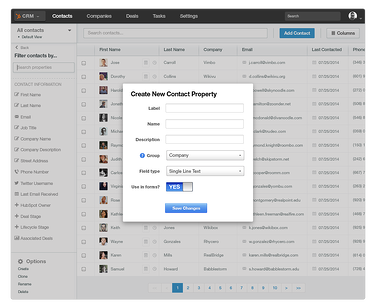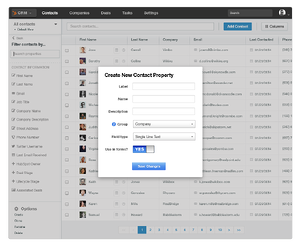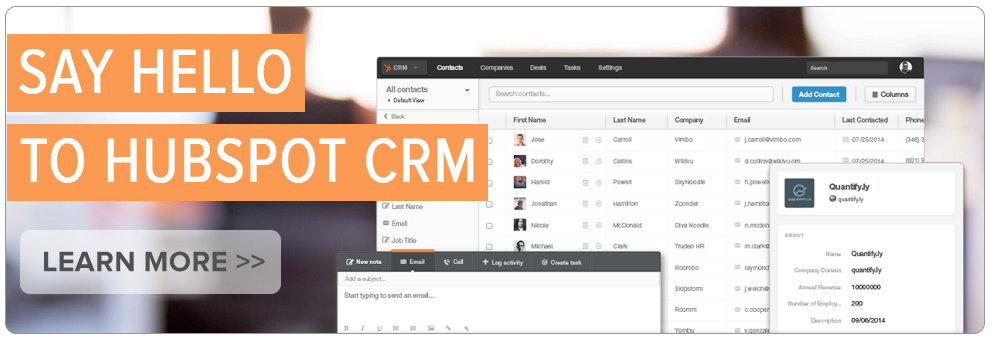Today at HubSpot’s (@hubspot) annual INBOUND  conference, co-founders Dharmesh Shah (@dharmesh) and Brian Halligan (@bhalligan) unveiled new customer relationship management (CRM) solutions.
conference, co-founders Dharmesh Shah (@dharmesh) and Brian Halligan (@bhalligan) unveiled new customer relationship management (CRM) solutions.
The HubSpot CRM collects and stores information on contacts, companies, deals and tasks in a centralized database. Additionally, Sidekick, the company’s evolved Signals product, provides real-time insights, notifications and tools when working outside of the platform.
Most notably, however, is a traditional “sales” software seamlessly made one with an integrated inbound marketing platform. Rather than patched together with an API, marketing and sales data, intelligence and activities are interwoven like never before. (Learn more about the HubSpot CRM here.)
We are moving closer to removing the silos dividing sales and marketing, and moving closer to true integration.
3 Rules for Sales and Marketing Integration
1. Full-Funnel Marketing Requires Marketing and Sales to Team Up
HubSpot calls it “smarketing”—a coordinated effort between sales and marketing that creates a consistent customer experience and aligns teams around revenue.
Marketing and sales teams must be in sync to maximize lead flow, customer conversions, revenue and profits. This requires strong communications, technology to facilitate collaboration, and a mutual commitment to achieve business goals.
When marketing hands off leads to sales, there must be processes in place to seamlessly transition the opportunities. CRM and automation technologies work together to nurture opportunities, update contact records and maximize conversion rates.
2. Strategies Must Be Driven by Data, and Actions Tied to Outcomes
By blending the data marketing and sales teams use, all touchpoints along the buying process can be mapped. From here, patterns emerge, weaknesses are pinpointed and activities are attributed to revenue.
Next-generation marketers have a clear understanding of how their actions impact business goals. Closed-loop sales monitoring and analytics ensure marketers can tie activities to metrics that matter, accurately attribute customer conversions to the appropriate marketing channels, easily identify bottlenecks in marketing campaigns and sales processes, and continually improve over time.
3. Businesses Need Next-Gen Marketing Tech, Talent and Strategy
The marketing technology matrix continues to expand, presenting an ever-growing array of marketing and sales technology solutions. As CMOs, CIOs and CMTs (chief marketing technologists) work to build their marketing technology stack, software providers like HubSpot are seeking to fill the gap with all-in-one solutions. Already, HubSpot has combined:
- Marketing backbone platforms (CRM, marketing automation, CMS, etc.)
- Marketing experiences (content marketing, social, personalization, SEO, etc.)
- Marketing operations (digital asset management, marketing analytics, web analytics, etc.)
As the marketing technology space matures, we’ll likely see others go down this same path.
Leveraging these tools requires advanced resources. Marketers must find (or develop) hybrid marketing talent adept at advanced marketing technologies, who are experts at inbound strategy. These prototype marketers must be able to deliver services across multiple marketing disciplines, including analytics, content, email, mobile, search, social, PR, and web. Additionally, marketing executives must build strategies that account for a new breed of consumer, and leverage the data, tech and talent at their fingertips.
What HubSpot’s CRM unveiled, more than anything, is the potential for businesses that align talent, technology and strategy, and build performance-driven strategies. It’s an exciting time for marketers. It’s time to do what old-school marketers never even dreamed possible.
Image Source: HubSpot

%20Logo_BlueOrange_Trademark.png?width=800&height=269&name=Ready%20North%20(RN)%20Logo_BlueOrange_Trademark.png)




.jpg?width=300&name=Services%20Hub%203%20(3).jpg)



COMMENTS